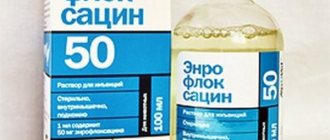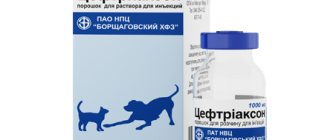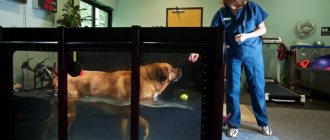Pharmacological properties
Ciprofloxacin is an antibiotic of the fluoroquinolone group, active against gram-positive and gram-negative bacteria, including Echerichia coli, Salmonella spp., Shigella spp., Klebsiella spp., Enterobacter spp., Proteus spp., Yersinia spp., Haemophilus spp., Pseudomonas aeruginosa, Pasteurella multocida, Plesiomonas shigelloides, Campylobacter jejuni, Brucella spp., Chlamydia trachomatis, Listeria monocytogenes, Mycobacterium spp., Corynebacterium diphtheriase, Staphylococcus spp. and Streptococcus spp. Succinic acid is a natural antioxidant.
Description of the drug Ciprovet
Ciprovet is a broad-spectrum veterinary drug that is used to treat diseases of bacterial origin. It is produced by the Russian organization NVC Agrovetzashchita LLC (Moscow region, Sergiev Posad), which specializes in medicines, vitamins and animal care products.
"Agrovetzashchita" is a research and development center that develops and produces veterinary drugs
The manufacturer of Tsiprolet has been developing unique formulas since 1993. The organization has more than 240 products, including antibiotics that are trusted not only by animal owners, but also by veterinarians.
Release form of the drug
Ciprovet is available in three dosage forms:
- Tablets (each 0.2 g). They are covered with a yellow shell and packaged in metallized blisters of 10 pieces. Each blister is packed in a separate cardboard box along with instructions for use.
- Eye drops. It is a transparent liquid without color or with a yellowish tint. The solution is packaged in polymer or glass bottles of 10 ml. Each bottle is packed in a cardboard box.
- Solution for injection 5%. A transparent, sterile, yellow liquid, packaged in brown glass bottles (10, 20, 50, 100 or 200 ml). Each bottle is sealed with a rubber stopper, which is rolled with an aluminum cap. There are cardboard boxes of 40 or 80 bottles, but most often you can find single packs.
The bottle of Ciprovet 5% is slightly different from the packaging of other dosage forms of the drug. Thus, the label of the bottle depicts several animals, because injections with this antibiotic can be prescribed not only to cats and dogs, but also to livestock. For poultry and cattle, there is another form of release of Tsiprovet - granules packaged in 1 kg.
An inexperienced cat owner may be inattentive in a hurry. So, in an emergency situation, you can lose your vigilance and buy a fake. Real Tsiprovet, regardless of the form of release, is marked with the manufacturer’s logo: a blue sign with the inscription “AVZ”.
Original drugs from Agrovetzaschita must have the organization’s logo
Photo gallery: Ciprovet preparations for cats
Ciprovet injection solution is intended for the treatment of more complex forms of bacterial infection
Ciprovet tablets are used in the treatment of bacterial diseases
Tsiprovet eye drops have anti-inflammatory and antibacterial properties
Table: composition of the drug
| Release form | Components | Content |
| Pills | Ciprofloxacin | 15 mg in 1 tablet |
| Eye drops | Ciprofloxacin | 0,45 % |
| Benzalkonium chloride | 0,05 % | |
| Trilon B | 0,08 % | |
| Water for injections | Up to 100% | |
| Injection | Ciprofloxacin | 50 mg/ml |
| succinic acid | 10 mg/ml | |
| Trilon B | 0.5 mg/ml | |
| Water for injections | Up to 1 ml |
Storage conditions for Tsiprovet
Tsiprovet should be stored in accordance with the manufacturer's recommendations: in a dry, dark place, away from food and cat food. It is most convenient to keep the drug together with other medications intended for pets, for example, in a medicine cabinet. The ideal storage temperature is between 5 and 25°C.
It is advisable for a cat owner to have a separate first aid kit for his pet.
Please note that the shelf life depends on the form of release of the drug:
- tablets - 4 years from the date of production;
- eye drops - 3 years (store an opened bottle for no more than 30 days);
- solution for injection - 2 years (opened bottle is valid for no more than 21 days).
Indications for use
- Prescribed for the treatment of dogs and cats with infectious diseases of the gastrointestinal tract, respiratory tract, genitourinary system, joints, soft tissues and skin, umbilical infections, atrophic rhinitis, bronchopneumonia, colibacillosis, salmonellosis, pasteurellosis, mycoplasmosis, other primary and secondary infections of bacterial etiology , the pathogens of which are sensitive to ciprofloxacin.
- Cattle, sheep, goats, pigs for infectious diseases of the gastrointestinal tract, respiratory tract, genitourinary system, joints, soft tissues and skin, necrobacteriosis, umbilical infections, atrophic rhinitis, bronchopneumonia, colibacillosis, salmonellosis, pasteurellosis, mycoplasmosis, mastitis syndrome -metrithalactia (MMA) and other infections whose pathogens are sensitive to ciprofloxacin.
Application procedure.
Inject dogs and cats 1 ml per 10 kg of body weight subcutaneously for 5-10 days.
"Ciprovet 5% for injection" is administered to farm animals subcutaneously or intramuscularly at a dose of 1 ml per 10 kg of animal weight (5 mg of ciprofloxacin per 1 kg of animal weight), once a day for 3-5 days, to pigs with MMA syndrome for 2 days.
The maximum volume of "Tsiprovet 5% for injection" for injection into one place should not exceed for cattle - 15 ml, pigs - 10 ml, sheep and calves - 5 ml, piglets - 2.5 ml, dogs - 2 ml and cats – 1 ml.
Contraindications
- Contraindicated in dairy animals, pregnant and lactating females, animals with kidney and liver diseases and disorders of the development of cartilage tissue, with damage to the nervous system, as well as puppies and kittens until the end of the growth period.
- With increased individual sensitivity of the animal to fluoroquinolones.
- Do not use simultaneously with bacteriostatic antibiotics (chloramphenicol, macrolides and tetracyclines), theophylline and non-steroidal anti-inflammatory drugs.
Side effects
Treatment with Ciprovet is contraindicated for:
- puppies up to six months;
- pregnant and lactating bitches;
- dogs with insufficient blood supply to the brain;
- animals with convulsions, convulsions, seizures due to diseases of the central nervous system.
Ciprovet should not be combined with other antibiotics or anti-inflammatory drugs. Preparations with magnesium, calcium and aluminum cations reduce the effectiveness of the drug.
If after drops of Ciprovet the dog starts having convulsions, you should stop taking it and find an analogue. Other symptoms of individual intolerance include vomiting, refusal to eat, swelling, and loss of coordination.
Tsiprovet is a non-hazardous drug. But the dog owner should take precautions. While breaking tablets or the injection procedure, you should not smoke, drink, or eat. All empty bottles must be disposed of along with the packaging. Once opened, the drops are usable for only 30 days. Other forms of the medicine can be stored until the expiration date out of the reach of children and pets.
Eye drops
The content of ciprofloxacin in eye drops is 0.45%. Also contains Trilon B, purified water and benzalkonium chloride. The medicine is produced in the form of a colorless or light yellow liquid, and is packaged in 10 ml polymer bottles. The bottles are easy to use, as they are equipped with a dropper pipette.
Note! After opening the bottle, the drops can only be used for 30 days.
Indications and contraindications
The instructions indicate that Ciprovet eye drops for cats are used for the following diseases:
- for conjunctivitis occurring in acute or chronic form;
- for blepharitis;
- for corneal ulcers;
- for keratitis;
- with septic iridocyclitis;
- with keratoconjunctivitis.
The drug can also be used to prevent the development of infectious pathologies in the following cases:
- after foreign objects get into the eye;
- after injuries of various types;
- after operations.
The medication should not be used for kittens under 7 days of age, or if they are intolerant to the components included in the composition. The drug has no other contraindications. If your pet has cerebral atherosclerosis, treatment with antibiotic eye drops should be carried out under the supervision of a doctor.
Features of application
Tsiprovet is instilled into the affected eye (or both) of cats, 1 drop. If the pathology is accompanied by purulent discharge, then the procedure is performed as follows:
- First, apply 3-4 drops.
- Gently wipe away the pus using a sterile gauze pad.
- Then reapply 1-2 drops.
You need to instill eye drops 3-4 times a day, and the course of treatment can be extended from 7 days to 2 weeks. If necessary, the course is repeated.
If Ciprovet is combined with other eye drops, a break of at least 5 minutes should be taken between instillations.
Pills
In addition to ciprofloxacin hydrochloride, the tablets contain lactulose, calcium stearate and other auxiliary components. The manufacturer has developed an innovative formula for an antibacterial agent. The main problem with the use of antibiotics is that intestinal dysbiosis often develops, but Ciprovet contains lactulose. It is a preobitic that promotes the proliferation of lactobacilli and bifidobacteria. For this reason, the intestinal microflora is restored faster after completing a course of antibacterial therapy.
Note! The manufacturer produces Ciprovet tablets for cats and dogs. They differ only in the content of the active substance (15 and 50 mg, respectively). When purchasing, select the product for its intended purpose to avoid overdose.
When to use
When using an antibiotic in tablet form, the active substance, along with the bloodstream, penetrates into all organs and tissues. It is used in the treatment of acute and chronic diseases caused by pathogenic microorganisms that are sensitive to ciprofloxacin. The antibacterial agent is effectively used to treat the following pathologies:
- bronchitis, pneumonia, tracheitis, sore throat and other inflammations of the respiratory system;
- enteritis, salmonellosis, dysentery and other gastrointestinal tract infections;
- hepatitis, pancreatitis and other inflammatory processes of the liver and pancreas;
- cystitis, inflammation of the kidneys and other organs of the genitourinary system;
- joint and bone infections;
- boils, phlegmon, inflammatory processes of soft tissues, including those accompanied by suppuration.
Often the medication is used to treat secondary infections that develop against the background of viral pathologies.
How to use
According to the instructions for use, Tsiprovet tablets are given to cats once a day. It is best to place the tablet on the root of the tongue to ensure that the animal swallows it. To reduce the likelihood of trauma to the pet’s mental state, the tablet can be hidden in a small amount of food, but it is important to make sure that he eats it.
The antibiotic dose is calculated according to the following scheme - 1 tablet per 3 kg of weight. The course of treatment can last from 3 to 5 days. In rare cases, the doctor prescribes the drug for a longer period. It is strictly prohibited to use an antibacterial agent without consulting a veterinarian.
Possible Limitations and Cautions
And although Tsiprovet is considered safe for cats, in some cases it is better not to use it:
- for pathologies of the nervous system that are accompanied by seizures;
- during lactation (the active substance penetrates into milk);
- when bearing offspring;
- for serious pathologies of cartilage tissue.
Note! It is strictly forbidden to use antibiotics for kittens during the growth period. It can have a negative impact on this process and cause serious developmental problems.
You cannot combine Ciprovet tablets with the following medications:
- other antibacterial agents;
- non-steroidal anti-inflammatory drugs;
- theophylline;
- medications that contain cations of aluminum, magnesium, calcium.
Since the drug is not compatible with all medications, complex therapy medications should be selected by a doctor.
Composition of the drug
The active component of Ciprovet for cats is ciprofloxacin, which is currently included in the list of the most effective antimicrobial agents from the group of fluoroquinolone derivatives.
The principle of this antimicrobial agent is based on the suppression of the bacterial enzyme DNA gyrase, which ensures the reading and copying of genetic information by daughter DNA molecules.
It causes:
- DNA replication disorder;
- cessation of bacterial cell growth and division;
- irreversible changes in organelles;
- destruction of the cell membrane.
The result of these processes is the rapid death of the microorganism.
Note! Cells of macroorganisms do not produce DNA gyrase, so Ciprovet does not have a harmful effect on them.
Gram-negative aerobic and anaerobic bacteria are most sensitive to ciprofloxacin, since the substance affects them both during the division period and during the resting phase.
These microbes include:
- coli;
- salmonella;
- shigella;
- Klebsiella;
- Protea and other representatives of enterobacteria;
- pseudomonas;
- Haemophilus influenzae;
- pasteurella;
- aeromonads;
- plasmidia;
- Campylobacter.
Gram-positive bacteria sensitive to antibiotics:
- staphylococci;
- streptococci;
- enterococci;
- mycobacteria.
The medicine affects them only during the division period.
Ciprofloxacin also affects intracellular parasites, the representatives of which are pathogens:
- brucellosis;
- chlamydia;
- listeriosis;
- corynebacteriosis.
Resistance to ciprofloxacin is demonstrated by:
- clostridia;
- Treponema;
- ureoplasma;
- pseudomonas.
Important! Therefore, treatment with Ciprovet for infections in cats caused by these microbes will be ineffective.
It has been established that the presented antimicrobial drug is destructive for microorganisms resistant to aminoglycosides, cephalosporins, representatives of the penicillin and tetracycline series.
After entering the animal’s gastrointestinal tract, Tsiprovet is absorbed by the epithelial cells of the small intestine, enters the blood vessels and is carried through the bloodstream to all tissues, internal organs, lymph, lacrimal and mammary glands, and the placenta.
The drug is active throughout the day, but its concentration reaches maximum values 1.5-2 hours after administration. Part of it is excreted unchanged in feces and urine, and the other part breaks down, reacts with organic compounds and leaves the body in the form of metabolites.
Important! Tsiprovet penetrates into the mammary glands and is excreted in milk during lactation. This explains the factor prohibiting the use of Ciprovet in cats while breastfeeding their offspring.
The composition of the drug, produced in the form of tablets, additionally includes lactulose, obtained artificially from milk sugar. Its beneficial effect on the functioning of the gastrointestinal tract of animals is manifested in retaining fluid in the intestinal lumen, stimulating its peristalsis, increasing the volume of feces, and improving the secretion of bile into the lumen of the duodenum. This leads to timely evacuation of feces, prevention of constipation and flatulence .
In addition, lactulose reaches the lumen of the large intestine unchanged. Here it decomposes under the influence of normal microflora, shifting the pH to the acidic side, creating unfavorable conditions for the development of pathogenic microorganisms.
Another important function of lactulose is to suppress putrefactive processes and reduce the amount of ammonia and hydrogen sulfide produced. By deoxidizing the environment, it impairs the absorption of toxic breakdown products into the blood, facilitating the functioning of the liver and kidneys.
By creating favorable conditions for the proliferation of beneficial bacteria involved in the formation of immunity, lactulose increases the cat’s body’s resistance to the effects of infectious agents.
Lactose was chosen as a filler, forming durable, non-hygroscopic tablets that do not deform or crumble during storage. This component does not affect the absorption and activity of the active substance.











